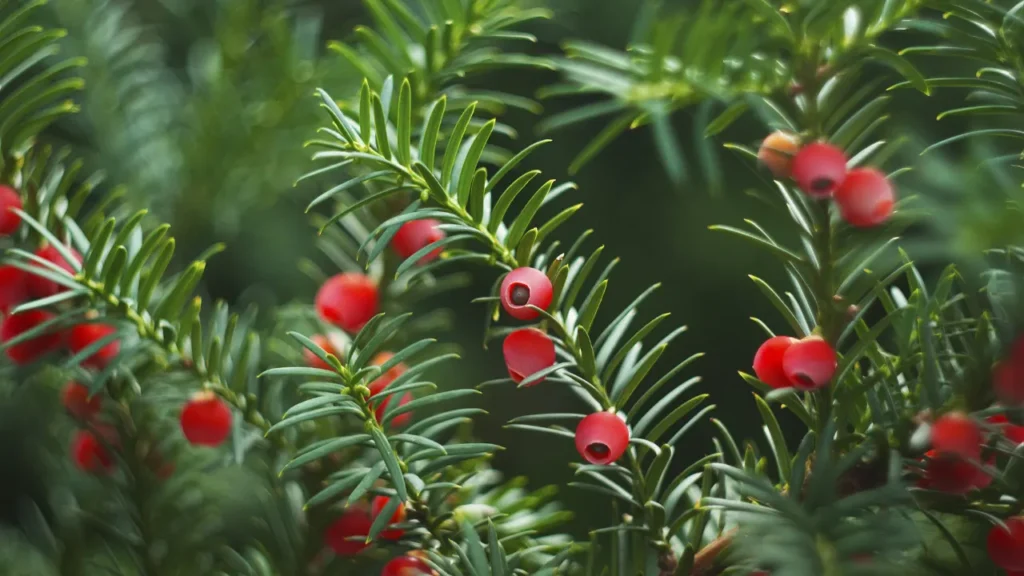Coniferous trees and shrubs in the genus Yew (Taxus spp.) are prized for their remarkable beauty and distinctive chemical makeup. Due to the discovery of various bioactive chemicals with possible health advantages, some species of Yew, including the European yew (Taxus baccata) and the Pacific yew (Taxus brevifolia), have attracted significant interest from the scientific community. Paclitaxel, a potent chemotherapeutic drug used in the treatment of many malignancies, is the most well-known of these substances.
However, yew also includes many other substances that have drawn interest for their possible therapeutic uses. This article seeks to provide a thorough examination of the nature, health advantages, recommended dosage, adverse effects, and potential drug interactions of yew, as well as details on the most ethical ways to utilize this dietary supplement.
You May Also Like:
Ginger: Benefits, Dosage, Side Effects, Drug Interactions, and Other Important Information
Globe Flower: Benefits, Dosage, Side Effects, Drug Interactions, and Other Important Information
Yew: Benefits, Dosage, Side Effects, Drug Interactions, And Other Important Information is an original (NootropicsPlanet) article.
Nature of Yew
Alkaloids, flavonoids, and terpenoids are just a few of the secondary metabolites that yew trees produce. These compounds shield the plants from herbivores, diseases, and environmental stressors. The yew tree produces these chemicals predominantly in its bark, needles, and seeds, which are extracted using various techniques, including solvent extraction, supercritical fluid extraction, and cold pressing. Due to their strong cytotoxic effects, taxane diterpenoids, especially paclitaxel and its analogs have drawn much interest among these secondary metabolites.
Health Benefits of Yew
- Anti-cancer effects: The anti-cancer qualities of yew are their most notable health benefit. One of the most important chemotherapy drugs, paclitaxel, was first discovered in the bark of the Pacific yew and is now used to treat a variety of cancers, including ovarian, breast, lung, and pancreatic cancer. Due to its efficacy and distinctive manner of action, it is a mainstay of many cancer therapy plans.
- Anti-inflammatory and antioxidant qualities: Flavonoids and taxifolin, two chemicals produced from yew, have potent anti-inflammatory and antioxidant actions, which may help explain their possible health advantages. These substances have been shown to scavenge reactive oxygen species and limit the synthesis of pro-inflammatory mediators, including tumor necrosis factor-alpha (TNF-alpha) and interleukin-6 (IL-6), shielding cells from oxidative damage.
- Neuroprotective effects: Mounting data points to the possibility that several yew chemicals possess neuroprotective qualities, making them promising candidates for treating neurodegenerative diseases. For instance, taxifolin has been demonstrated to prevent amyloid-beta plaque formation and oxidative stress-induced cell death in neuronal cells, which are thought to contribute to the pathophysiology of Alzheimer’s disease. Additionally, flavonoids extracted from yew have shown promise in reducing neuroinflammation and encouraging neurogenesis, supporting their potential function in neuroprotection.

Chemistry of Yew
Due to the plant’s wide variety of bioactive chemicals, yew’s chemistry is complex. These substances can be roughly categorized into several groups, including phenolic chemicals, alkaloids, flavonoids, and terpenoids. The chemical makeup of yew can be better understood by looking more closely at these subcategories.
- Alkaloids: Yew alkaloids are chemical substances with nitrogen and a heterocyclic ring structure. Taxine, a very toxic substance that can result in cardiac arrest and death in both humans and animals, is the most well-known yew alkaloid. Taxine is found primarily in yew tree seeds and leaves; it is not found in the bark preparations commonly utilized for medicinal purposes.
- Flavonoids: Yew flavonoids are a class of polyphenolic compounds with a characteristic C6-C3-C6 structure. These compounds, which include catechins, quercetin, and kaempferol, exhibit potent antioxidant and anti-inflammatory properties, contributing to the potential health benefits of yew. Flavonoids are primarily found in the needles and bark of yew trees.
- Terpenoids: Isoprene, an organic molecule with five carbons, is the source of the broad and diversified class of terpenoids, commonly referred to as isoprenoids. Taxane diterpenoids, like paclitaxel, and its analogs, which have a distinct taxane ring structure, are examples of yew terpenoids. The powerful anti-cancer capabilities of yew result from these chemicals, which are mostly present in the bark and needles of yew trees.
- Phenolic substances: The broad class of yew phenolic substances includes substances with one or more hydroxyl groups joined to an aromatic ring. These substances, including lignans, stilbenes, and phenolic acids, display a variety of biological actions, including anti-inflammatory, anti-cancer, and antioxidant effects. The bark, needles, and seeds of the yew tree, among other parts, contain phenolic chemicals.
Overall, depending on the species, plant component, and extraction technique, the chemistry of yew is highly complex and variable. Yew have a variety of possible health advantages, but their complexity also creates difficulties for standardization, safety, and efficacy. More study is required to comprehend the chemistry of yew completely and realize its medicinal and nutritional potential.
Physiological Mechanisms of Action
Paclitaxel, the most extensively researched chemical identified in yew, works against cancer by stabilizing microtubules and inhibiting their depolymerization. Microtubules are crucial components of the cell’s cytoskeleton, playing essential roles in cell division, intracellular transport, and cell shape preservation. Paclitaxel disrupts normal cell division by stabilizing microtubules, resulting in cell cycle arrest and cell death in rapidly dividing cancer cells.
Yew contains various bioactive chemicals with potential therapeutic applications in addition to paclitaxel. These chemicals can affect multiple signaling pathways involved in inflammation, oxidative stress, and cell survival, making them appealing therapeutic development targets. Some yew flavonoids, for example, have been proven to have anti-inflammatory and antioxidant characteristics. At the same time, other components, such as taxifolin, have been shown to have anti-cancer, anti-diabetic, and neuroprotective capabilities.


Optimal Dosage of Yew
The appropriate dosage of yew for therapeutic application is difficult to determine because the efficacy and safety of these compounds depend on various factors, including the individual chemical, formulation, and target ailment. Paclitaxel dosage and delivery schedule for different cancer types are well-established, with usual dosages ranging from 135 to 175 mg/m2, taken intravenously over 3 to 24 hours and repeated every three weeks.
The ideal dosage for other yew-derived chemicals, such as taxifolin or flavonoids, is less obvious and may vary depending on the targeted health benefits and individual characteristics such as age, body weight, and health state. More clinical research is needed to create evidence-based dose guidelines for these substances, and individuals should speak with a healthcare professional before introducing yew into their therapeutic regimen.
Side Effects of Yew
Yew, particularly those containing paclitaxel, can cause serious side effects, particularly at large doses or when administered intravenously. Paclitaxel commonly causes the following adverse effects:
- Paclitaxel can induce a decrease in the amount of blood cells, increasing the risk of infections, anemia, and bleeding.
- Peripheral neuropathy: Paclitaxel-induced nerve damage can cause numbness, tingling, or pain in the hands and feet.
- Allergic responses to paclitaxel or its excipients: Allergic reactions to paclitaxel or its excipients can range from moderate skin rashes to severe anaphylactic events.
- Cardiotoxicity: Although it is uncommon, paclitaxel can cause potentially serious heart adverse effects like arrhythmias or heart failure.
Less is known about the adverse effects of other yew-derived chemicals, such as taxifolin or flavonoids, but they are generally considered safer than paclitaxel. However, like with any supplement, use caution and contact a healthcare expert before use.


Potential Substance Interactions with Yew
Yew, especially those containing paclitaxel, may interact with a variety of drugs, potentially affecting their efficacy or increasing the risk of side effects. Among the notable interactions are:
- Inhibitors of the CYP3A4 enzyme: Paclitaxel is primarily metabolized by the CYP3A4 enzyme. Concurrent use of CYP3A4 inhibitors such as ketoconazole, erythromycin, or grapefruit juice can enhance paclitaxel exposure, potentially leading to more side effects.
- CYP3A4 inducers: Conversely, CYP3A4 inducers such as rifampin or phenytoin might lower paclitaxel levels, potentially lowering its efficacy.
- Anticoagulants: Because of their potential antiplatelet properties, yew may raise the risk of bleeding when used with anticoagulants such as warfarin.
Best Responsible Uses of Yew
A detailed awareness of the advantages, hazards, and potential interactions with other substances is required to responsibly use yew as a nutritional supplement or medicinal agent. Individuals thinking about using yew should:
- Speak with a healthcare practitioner: Before introducing yew into their regimen, consumers should speak with a healthcare provider to see whether the supplement is appropriate for their unique needs and health situation. A healthcare professional can advise you on the best dosage and administration schedule.
- Select high-quality products: When buying yew extracts or supplements, people should look for items made by renowned companies that comply with strict quality control standards. This guarantees that the extracts are free of impurities and have an adequate concentration of bioactive components.
- Be aware of potential side effects and interactions: It is critical for people who use yew to be aware of potential side effects and interactions with other medications and report any bad reactions to their healthcare provider as soon as possible.
- Exercise caution while self-experimenting: While using yew as a nutritional supplement responsibly may give possible health advantages, avoiding self-experimentation with large doses or untested formulas is critical. This can result in unanticipated hazards and bad health repercussions.
Yew:
Conclusion
While the yew tree contains compounds with potential medicinal properties, such as taxanes, it also contains toxic alkaloids, including taxine. The use of yew in traditional medicine and modern pharmacology has primarily focused on its anti-cancer properties, particularly in the treatment of certain types of cancer, such as breast and lung cancer. However, the toxicity of yew, its potential side effects, and the environmental concerns associated with its harvesting must be carefully considered.
Furthermore, while research continues into other possible health benefits of yew, such as its cardiovascular and anti-inflammatory properties, further studies are needed to understand these effects fully and determine safe and effective therapeutic applications. As with any herbal remedy or pharmaceutical agent, consulting with healthcare professionals is essential before using yew-derived products for medicinal purposes.


References:
- Paclitaxel: Mechanisms of action, resistance, and the role of the microenvironment in response to treatment. Retrieved from: https://www.nature.com/articles/nrc1630
- Gottesman, M. M., Fojo, T., & Bates, S. E. (2002). Multidrug resistance in cancer: Role of ATP–dependent transporters. Nature Reviews Cancer, 2(1), 48-58. Retrieved from: https://www.nature.com/articles/nrc706
- Harborne, J. B., & Williams, C. A. (2000). Advances in flavonoid research since 1992. Phytochemistry, 55(6), 481-504. Retrieved from: https://www.sciencedirect.com/science/article/abs/pii/S0031942200002600
Important Note: The information contained in this article is for general informational purposes only, and should not be construed as health or medical advice, nor is it intended to diagnose, prevent, treat, or cure any disease or health condition. Before embarking on any diet, fitness regimen, or program of nutritional supplementation, it is advisable to consult your healthcare professional in order to determine its safety and probable efficacy in terms of your individual state of health.
Regarding Nutritional Supplements Or Other Non-Prescription Health Products: If any nutritional supplements or other non-prescription health products are mentioned in the foregoing article, any claims or statements made about them have not been evaluated by the U.S. Food and Drug Administration, and such nutritional supplements or other health products are not intended to diagnose, treat, cure, or prevent any disease.
